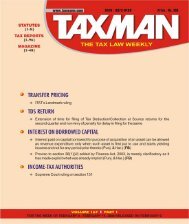news round up - Taxmann
news round up - Taxmann
news round up - Taxmann
- TAGS
- news
- round
- taxmann
- taxmann.com
You also want an ePaper? Increase the reach of your titles
YUMPU automatically turns print PDFs into web optimized ePapers that Google loves.
136 GOODS & SERVICES TAX - MAGAZINE [Vol. 1<br />
in this value chain (such as excise duty on manufacture, VAT on sale, etc.).<br />
As these taxes are levied on different taxable events they have their<br />
limitations. To illustrate further, let’s take an example of excise duty.<br />
Excise duty is levied on ‘manufacture’ and it fails to tax the value addition<br />
at distribution level. Additionally, at present, ‘goods’ suffer two levies<br />
(Excise and VAT) whereas ‘taxable services’ suffer only one levy, i.e.,<br />
service tax. This leads to distortion: distortion arises because the relative<br />
prices of services would be lower as compared to goods. Even, as current<br />
tax system treats goods and services differently, in certain cases there is<br />
double taxation (software being one of such case where the industry has<br />
taken conservative stand and both VAT and service tax is being currently<br />
levied). Also, there are restrictions on availment of credit such as a service<br />
provider cannot avail credit of VAT and a trader cannot avail credit of<br />
service tax.<br />
The above lacunas affect free flow of goods and services. Additionally, it<br />
brings uncertainty in the trade which is not good for the economy as a<br />
whole. GST is now being projected as a solution to all these problems.<br />
Whether GST will cure all the problems prevalent in the current tax<br />
structure?<br />
Though not all, but surely, most of the current issues will be resolved such<br />
as the classification, valuation, double taxation disputes, etc. On a positive<br />
note, most of the credit which is not available will be available in GST<br />
regime such as the service provider will be eligible to avail credit of VAT,<br />
luxury tax, entertainment tax, etc. The compliances are also expected to<br />
reduce drastically.<br />
How GST is different from the current taxes?<br />
GST is different from the current tax structure in many ways. Currently,<br />
taxes treat goods and services differently. As mentioned above, ‘goods’<br />
attract excise at manufacturing level and VAT at the time of sale. In<br />
contrast, services attract only one levy, i.e., service tax on provision of<br />
taxable services.<br />
This distinction, in GST regime, would lose its importance as both goods<br />
and services would be treated at par for taxing purposes. A transaction in<br />
goods and services for a consideration would attract CGST and SGST.<br />
Also, the State Government now gets the power to tax services and Central<br />
Government gets the power to levy tax at the distribution and retail level.<br />
When would GST be introduced?<br />
As the <strong>news</strong> are unfolding, the proposed date, i.e., April 2010 for implementing<br />
GST seems unlikely. However, any date near October 2010 or<br />
April 2011 seems likely.<br />
What about the legislations and the rules?<br />
GST would be implemented with single CGST statute which would be<br />
applicable across India. However, for SGST, each State will have its own<br />
GOODS & SERVICES TAX CASES ❑ JANUARY 20 - FEBRUARY 4, 2010 ◆ 46











![“FORM NO. 3CEB [See rule 10E] Report from an ... - Taxmann](https://img.yumpu.com/45480232/1/190x245/form-no-3ceb-see-rule-10e-report-from-an-taxmann.jpg?quality=85)





